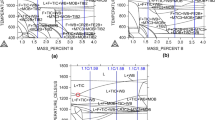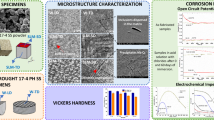Abstract
The structural-phase states and tribological properties of 12Kh18N10T steel subjected to electroexplosive alloying (EPA) with titanium and boron and subsequent electron-beam processing in various modes in terms of the energy density of the electron beam and the duration of the exposure pulse have been analyzed using methods of modern physical materials science. It has been established that EPA of steel with titanium and boron leads to the formation of a surface layer with multiphase submicro-nanocrystalline structure, characterized by the presence of micropores, microcracks, and microcraters. Complex processing, combining EPA and subsequent irradiation with high-intensity pulsed electron beams, leads to the formation of 60-μm-thick multiphase submicro-nanocrystalline surface layer. It is shown that the phase composition of a surface layer of steel is determined by the mass ratio of titanium and boron during electroexplosive alloying. The microhardness of a modified layer is defined by the relative mass fraction of titanium borides in the surface layer and can be more than 18 times higher than the microhardness of steel in its initial state (before electroexplosive alloying). Modes of complex processing have been determined at which the surface layer containing exclusively titanium borides and intermetallic compounds based on titanium and iron is formed. The maximum (approximately 82% by weight) titanium boride content is observed when steel is processed in a regime with the highest mass of boron powder in the sample (mB = 87.5 mg; mTi/mB = 5.202). With a decrease in mass of boron powder, the relative content of borides in the surface layer of steel decreases. It was found that integrated processing of steel is accompanied by a sevenfold increase in microhardness of the surface layer and wear resistance of the steel increases by more than nine times.






Similar content being viewed by others
REFERENCES
Shulga, A.V., A comparative study of the mechanical properties and the behavior of carbon and boron in stainless steel cladding tubes fabricated by PM HIP and traditional technologies, J. Nucl. Mater., 2013, vol. 434, nos. 1–3, pp. 133–140.
Ma, S. and Zhang, J., Wear resistant high boron cast alloy—A review, Rev. Adv. Mater. Sci., 2016, vol. 44, no. 1, pp. 54–62.
Zhang, J., Gao, Y., Xing, J., Ma, S., Yi, D., Liu, L., and Yan, J., Effects of plastic deformation and heat treatment on microstructure and properties of high boron cast steel, J. Mater. Eng. Perform., 2011, vol. 20, no. 9, pp. 1658–1664.
Saha, R. and Ray, R.K., Development of texture, microstructure, and grain boundary character distribution in a high-strength boron-added interstitial-free steel after severe cold rolling and annealing, Metall. Mater. Trans. A, 2009, vol. 40, no. 9, pp. 2160–2170.
Saha, R. and Ray, R.K., Microstructural and textural changes in a severely cold rolled boron-added interstitial-free steel, Scr. Mater., 2007, vol. 57, no. 3, pp. 841–844.
He, L., Liu, Y., Li, J., and Li, B.H., Effects of hot rolling and titanium content on the microstructure and mechanical properties of high boron Fe–B alloys, Mater. Des., 2012, vol. 36, no. 4, pp. 88–93.
Liu, Y., Li, B.H., Li, J., He, L., Gao, S.J., and Nieh, T.G., Effect of titanium on the ductilization of Fe–B alloys with high boron content, Mater. Lett., 2010, vol. 64, no. 11, pp. 1299–1301.
Samsonov, G.V., Markovskii, L.Ya., Zhigach, A.F., and Valyashko, M.G., Bor. Ego soedineniya i splavy (Boron Compounds and Alloys), Samsonov, G.V., Ed., Kiev: Akad. Nauk UkrSSR, 1960.
Ren, X., Fu, H., Xing, J., and Yi, Y., Effect of solidification rate on microstructure and toughness of Ca–Ti modified high boron high speed steel, Mater. Sci. Eng., A, 2019, vol. 742, pp. 617–627.
Gribkov, V.A., Grigor’ev, F.I., Kalin, B.A., and Yakushin, V.L., Perspektivnye radiatsionno-puchkovye tekhnologii obrabotki materialov. Uchebnik (Prospective Radiation-Beam Technologies for Materials Processing: Manual), Moscow: Kruglyi Stol, 2001.
Koval’, N.N. and Ivanov, Yu.F., Nanostructuring of surfaces of metalloceramic and ceramic materials by electron-beams, Russ. Phys. J., 2008, vol. 51, no. 5, pp. 505–516.
Poate, J.M., Foti, G., and Jacobson, D.C., Surface Modification and Alloying: By Laser, Ion, and Electron Beams, New York: Springer, 1983.
Shulov, V.A., Paikin, A.G., Novikov, A.S., et al., Sil’notochnye elektronnye impul’snye puchki dlya aviatsionnogo dvigatelestroeniya (High-Voltage Electronic Pulsed Beams for Aircraft Engines), Shulov, V.A., Novikov, A.S., and Engel’ko, V.I., Eds., Moscow: Artek, 2012.
Kadyrzhanov, K.K., Komarov, F.F., Pogrebnyak, A.D., et al., Ionno-luchevaya i ionno-plazmennaya modifikatsiya materialov (Ion-Beam and Ion-Plasma Modification of Materials), Moscow: Mosk. Gos. Univ., 2005.
Uglov, V.V., Cherenda, N.N., Anishchik, V.M., Astashinskii, V.M., and Kvasov, N.T., Modifikatsiya materialov kompressionnymi plazmennymi potokami (Modification of Materials by Compression Plasma Flows), Minsk: Bel. Gos. Univ., 2013.
Budovskikh, E.A., Martusevich, E.V., Nosarev, P.S., Gromov, V.E., and Sarychev, V.D., Osnovy tekhnologii obrabotki poverkhnosti materialov impul’snoi geterogennoi plazmoi (Theoretical Fundamentals of Materials Surface Treatment by Pulsed Heterogeneous Plasma), Novokuznetsk: Sib. Gos. Ind. Univ., 2002.
Bagautdinov, A.Ya., Budovskikh, E.A., Ivanov, Yu.F., and Gromov, V.E., Fizicheskie osnovy elektrovzryvnogo legirovaniya metallov i splavov (Physical Fundamentals of Electroexplosive Alloying of Metals and Alloys), Novokuznetsk: Sib. Gos. Ind. Univ., 2007.
Konovalov, S., Gromov, V., and Ivanov, Yu., Multilayer structure of Al–Si alloy after electro-explosion alloying with yttrium oxide powder, Mater. Res. Express, 2018, vol. 5, no. 11, art. ID 116520.
Romanov, D.A., Gromov, V.E., Budovskikh, E.A., and Ivanov, Yu.F., Regularities of structural phase states formation on surface of metals and alloys during electroexplosive alloying, Usp. Fiz. Met., 2015, vol. 16, no. 2, pp. 119–157.
Struktura, fazovyi sostav i svoistva poverkhnostnykh sloev titanovykh splavov posle elektrovzryvnogo legirovaniya i elektronno-puchkovoi obrabotki (Structure, Phase Composition and Properties of Surface Layers of Titanium Alloys after Electroexplosive Alloying and Electron-Beam Processing), Gromov, V.E., Ivanov, Yu.F., and Budovskikh, E.A., Eds., Novokuznetsk: Inter-Kuzbass, 2012.
Sorokin, V.G., Volosnikova, A.V., Vyatkin, S.A., et al., Marochnik stalei i splavov (Grade Guide of Steels and Alloys), Sorokin, V.G., Ed., Moscow: Mashinostroenie, 1989.
Rotshtein, V., Ivanov, Yu., and Markov, A., Surface treatment of materials with low-energy, high-current electron beams, in Materials Surface Processing by Directed Energy Techniques, Pauleau, Y., Ed., Amsterdam: Elsevier, 2006, pp. 205–240.
Krishtal, M.M., Yasnikov, I.S., Polunin, V.I., Filatov, A.M., and Ul’yanenkov, A.G., Skaniruyushchaya elektronnaya mikroskopiya i rentgenospektral’nyi analiz v primerakh prakticheskogo primeneniya (Scanning Electron Microscopy and X-Ray Spectral Analysis in Practice), Krishtal, M.M., Ed., Moscow: Tekhnosfera, 2009.
Diagrammy sostoyaniya dvoinykh metallicheskikh sistem: Spravochnik (State Diagrams of Binary Metal Systems: Handbook), Lyakishev, N.P., Ed., Moscow: Mashinostroenie, 1996, vol. 1.
Utevskii, L.M., Difraktsionnaya elektronnaya mikroskopiya v metallovedenii (Diffraction Electron Microscopy in Metal Science), Moscow: Metallurgiya, 1973.
Tomas, G. and Goringe, M.J., Transmission Electron Microscopy of Materials, New York: Willey, 1979.
Andrews, K.W., Dyson, D.J., and Keown, S.R., Interpretation of Electron Diffraction Patterns, London, 1968.
Transmission Electron Microscopy Characterization of Nanomaterials, Kumar, C.S.S.R., Ed., New York: Springer, 2014.
Williams, D.B. and Carter, C.B., Transmission Electron Microscopy: A Textbook for Materials Science, Berlin: Springer, 2016.
Egerton, R.F., Physical Principles of Electron Microscopy, Berlin: Springer, 2016.
Funding
The study was financially supported by grants of the Russian Science Foundation (project no. 18-79-00013 (experiments on electrical explosive alloying) and project no. 19-19-00183 (electron microscopy)).
Author information
Authors and Affiliations
Corresponding authors
Additional information
Translated by A. Muravev
About this article
Cite this article
Ivanov, Y.F., Gromov, V.E., Romanov, D.A. et al. Liquid-Phase Boriding of High-Chromium Steel. Steel Transl. 50, 452–459 (2020). https://doi.org/10.3103/S0967091220070062
Received:
Revised:
Accepted:
Published:
Issue Date:
DOI: https://doi.org/10.3103/S0967091220070062




